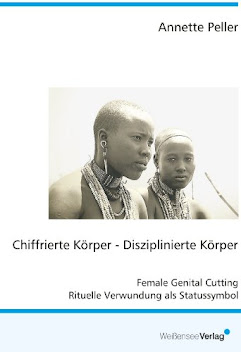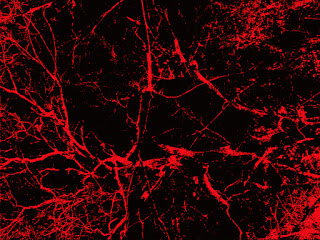Ciphered Bodies - Disciplined Bodies
As an addendum to what I have written before, I would like to write down some of the aspects Annette Peller pointed out in her book ‘Chriffierte Körper – Disziplinierte Körper. Female Genital Cutting. Rituelle Verwundung als Statussymbol’.
To my knowledge, there
is no English translation of the book. The title would probably read as
follows: Ciphered Bodies - Disciplined Bodies. Female genital cutting.
Ritual wounding as a status symbol '. The book represents her PhD thesis
and was written in 2000.
First, Annette Peller prefers to use the word ‘Excision’ instead of cutting or mutilation, since it is somewhat more neutral and the term is better able to handle certain aspect of ritual wounding.
Annette Peller did much of her research while living with the Arbore and other ethnic groups in Southern Ethiopia.
A girl or woman who wants to undergo such body modifications (or ritual punishments, like flogging) must be willing and able to endure strong pain and to accept non-reversible body changes. After finishing, her ability to suffer pain is regarded as a sign of strong character and a firm commitment to the group values (group cohesion).
Annette Peller is well aware of the harmful consequences of such rituals, but she also emphasizes that such rituals are (still) a necessary part of a group or tribe culture and ethnic identity. Therefore, in order to stop or change such rituals, much effort has to be put into changing their world of living (tribal understanding of marital value assessment of a woman).
Besides excision, she
also lists other rituals like the knocking out of a lower front tooth, people
modifying their body with lip plates or with elongated body parts (like the
neck). The common denominator seems to be the need to belong to a certain
ethnic group and to obtain their acceptance.
Group values are very important and adhering to their practice is demanded from all group members - who often themselves strongly wish to undergo such body changing rituals since they want to be a respected member of the group.
Body modifications can be seen in mostly all cultures around the world, like piercing, tattoos, decorative scars (like the ones from fencing), body painting … and the like.
She also refers to some historical explanations:
·
Excision as a form of male dominance and the attempt to domesticate or
reduce female sexuality
·
Excision should limit the girls vulnerability since they become less
interesting for human predators and wild animals (since their body odor is
reduced). Remark: in some societies it is forbidden for menstruating women to
approach herds of beef or camels. This may be a reason why women are usually excluded
from hunt since their body odor could attract predators.
·
Excision (incl. infibulation) as a form of birth control in order to limit
the use of scarce resources
·
Excision was practiced by members of upper social castes (like the king’s
woman or members of the royal family), or enforced onto members of low social status
like female slaves.
·
Excision was practiced in order to cut off the ‘representation or
incorporation of the male soul’ in a woman (i.e. the clitoris) or the
representation or incorporation of the female soul in a man (i.e. the prepuce).
Such belief of bisexuality was / is common by certain African tribes.
Some of these aspects (true
or not) were new to me and I find them interesting as they may explain certain aspects
of the origin of excision (Female Genital Mutilation, Female Genital
Cutting, and other terms of description).
As you and I have certainly noticed, this matter is very complex and demands a multi-factorial approach to limit, reduce or avoid such practices, especially since there are other more benign means of socialization and to gain cultural identity and value.




Comments
Post a Comment